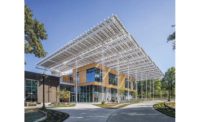The Shangri La Botanical Gardens & Nature Center in Orange is one of the Top 10 Green Projects this year, selected by the American Institute of Architects Committee on the Environment.
Located on 252 acres, the center houses wetlands demonstration and ornamental gardens, and an interpretive center for ecosystems such as cypress and tupelo swamp, wooded uplands and prairie lowlands.
The AIA/COTE competition is based on elements including intent and innovation, site, bioclimatic design, light and air, water, energy.
Lake/Flato Architects of San Antonio designed the project, and Beck Group of Austin was the contractor.
The AIA is just one group working to promote sustainable building.
The U.S. Green Building Council, which started the Leadership in Energy and Environmental Design, or LEED, program in 1998, is the best known of the organizations that promote such efforts.
LEED is on its way to beiing the preferred green designation with the federal government’s mandate that new buildings be LEED certified.
“LEED is becoming more of an industry standard than some obscure movement out there,” says John Harchelroad, contract manager in the health-care division of Hoar Construction LLC in Birmingham.
Harchelroad has achieved the LEED Accredited Professional designation that has gone to 40,000 individuals since its start in 2001.
The USGBC’s building-certification system covers a range of construction, from rehab to schools to the health-care specifications.
LEED certification is based on third-party review of a project’s design, construction and performance in energy and water efficiency, materials and resource use, sustainable site development and indoor air quality.
Some critics call LEED too expensive because the third-party entity has to verify that plans, waste, systems and the like meet the USGBC’s exacting standards, and because some of the platforms may not generate a return on the investment until later than owners want.
Government-owned or -occupied buildings made up more than one-fourth of all LEED projects at the end of the first quarter of this year, according to the USGBC.
The nonprofit USGBC has teamed with a range of organizations including the Clinton Climate Initiative and its Energy Efficiency Building Retrofit Program, Building Owners and Managers Association International.
Global Green, the U.S. branch of Green Cross International, promotes green buildings and cities. It follows the LEED outline for building.
The National Green Building Standards, a voluntary self-verification program, was developed by the American National Standards Institute and the National Association of Home Builders. It also has multilevel ratings.
The Collaborative for High Performance Schools, a San Francisco-based nonprofit, took the LEED model for new construction in 2001 and adapted it to apply to all schools, especially those in California. CHPS facilities have been built or are under way in several states.
CHPS has since participated in development of the LEED for Schools rating but continues working with professionals to develop state-by-state guidelines. It released the benchmark for Texas earlier this year.
The Associated Builders and Contractors and the Associated General Contractors have endorsed the green building approach and formed advisory groups, added green Web sites and tied in with other organizations.
Commercial builders can also tie in to the Green Building Initiative’s Green Globes online self-assessment to measure their own green progress.
The Sustainable Buildings Industry Council, which got its start as the Passive Solar Industries Council, offers a clearinghouse of sustainable building information and the Whole Building Design Guide.
Federal government programs include the Energy Star of the U.S. Environmental Protection Agency and the U.S. Department of Energy.
States are getting more organized about green building. In California, a statewide building code is voluntary until 2010, when it becomes mandatory. The code calls for a 50% increase in landscape water conservation and a 15% increase in energy efficiency. It applies to residential and commercial; public and private construction; and all schools, hospitals and other public institutions. –By Candy McCampbell


Post a comment to this article
Report Abusive Comment